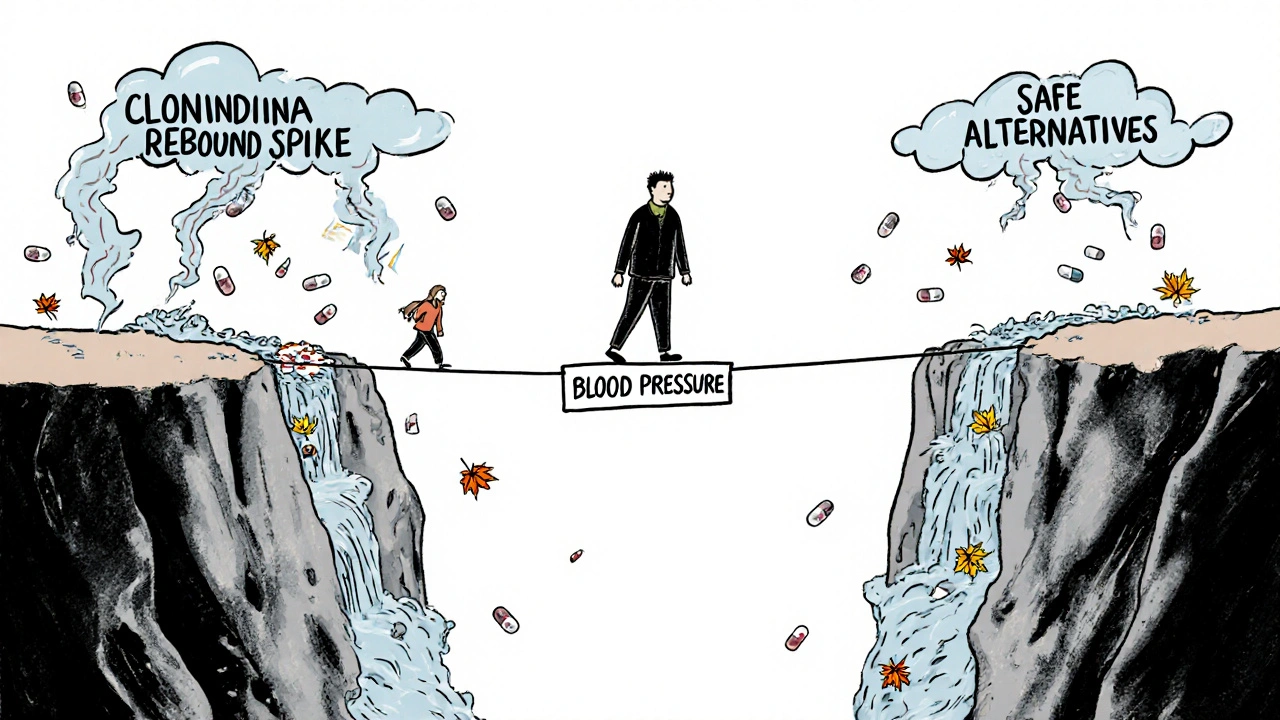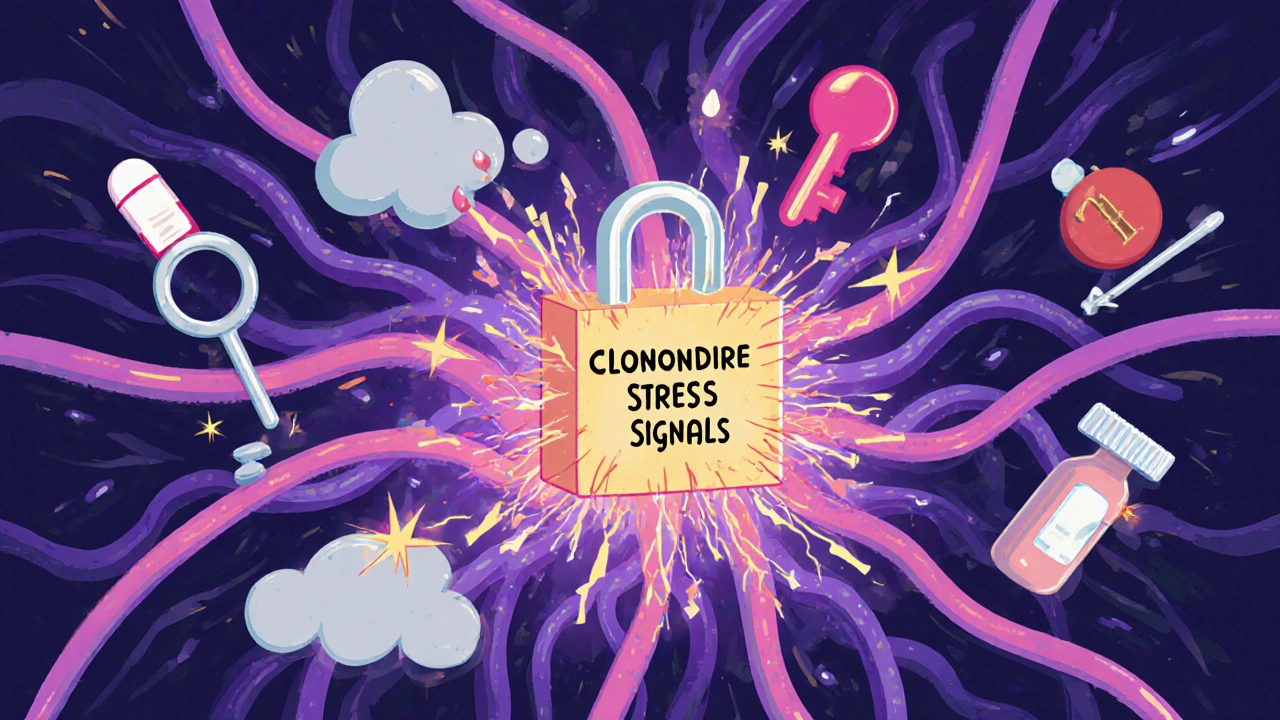Clonidine isn’t the first drug most people think of when they hear high blood pressure, but it’s been used for decades - and still shows up in prescriptions today. It’s also prescribed off-label for anxiety, ADHD, opioid withdrawal, and even sleep issues. But if you’re taking it now, or your doctor suggested it, you might be wondering: are there better options? What else works just as well - or better - without the same side effects?
Clonidine works by calming down your nervous system. It lowers heart rate and relaxes blood vessels, which brings down blood pressure. But it doesn’t fix the root cause. It just masks the symptoms. And for many, the trade-offs aren’t worth it.
How Clonidine Actually Works
Clonidine is an alpha-2 adrenergic agonist. That’s a fancy way of saying it tricks your brain into thinking your body is already relaxed. It tells your brain to stop sending out stress signals that make your heart race and your blood vessels tighten. This lowers blood pressure quickly - sometimes too quickly.
But here’s the catch: Clonidine doesn’t just affect your blood pressure. It hits receptors all over your nervous system. That’s why people report dry mouth, drowsiness, constipation, and even sudden drops in blood pressure when standing up. Some users feel foggy, tired, or depressed. And if you stop taking it suddenly? Your blood pressure can spike dangerously high - a rebound effect that’s been documented in hospital emergency rooms.
Clonidine’s effects wear off fast. Most people need to take it two to four times a day. That’s hard to stick with. Miss a dose? Your numbers can climb within hours. That’s why many patients and doctors look for alternatives that are easier to manage - and safer long-term.
Best Alternatives to Clonidine for High Blood Pressure
If your goal is to lower blood pressure without the rollercoaster side effects, here are the most commonly used and well-studied options.
1. Lisinopril (ACE Inhibitor)
Lisinopril is one of the most prescribed blood pressure meds in the U.S. and Australia. It works by blocking a hormone that narrows blood vessels. Unlike Clonidine, it doesn’t make you sleepy or dry-mouthed. It’s taken once daily, has a long track record, and is often used as a first-line treatment.
Studies show it reduces stroke risk by up to 25% over five years compared to older drugs like beta-blockers. It’s also cheaper - generic lisinopril costs under $5 a month in most places. Side effects? A dry cough in about 10% of users, and rare cases of swelling. But for most, it’s far more tolerable than Clonidine.
2. Amlodipine (Calcium Channel Blocker)
Amlodipine relaxes the muscles in your artery walls, letting blood flow more easily. It’s especially good for older adults and people of African descent, who often respond better to calcium channel blockers than ACE inhibitors.
It’s once-daily, has minimal sedation, and doesn’t cause dizziness when standing. Swelling in the ankles is the most common side effect - but that’s usually mild and manageable. Unlike Clonidine, there’s no dangerous rebound effect if you miss a dose.
3. Losartan (ARB)
Losartan works like lisinopril but blocks a different part of the same pathway. It’s often chosen if you can’t tolerate the cough from ACE inhibitors. It’s also kidney-protective, which matters if you have diabetes or early kidney damage.
One 2023 study in the Journal of Hypertension found losartan was just as effective as Clonidine at lowering blood pressure - but with 60% fewer reports of fatigue and dizziness.
4. Hydrochlorothiazide (Diuretic)
This is the original “water pill.” It helps your kidneys flush out extra salt and water, which reduces blood volume and pressure. It’s often combined with other meds, especially in older patients.
It’s cheap, effective, and doesn’t cause drowsiness. But it can lower potassium levels, so your doctor may check your blood work every few months. It’s not as strong as Clonidine for rapid drops in pressure, but it’s much safer for daily use.
Alternatives to Clonidine for Anxiety and Sleep
Many people are prescribed Clonidine for anxiety - especially if they have PTSD, panic attacks, or are trying to quit stimulants. But it’s not FDA-approved for this. There are better, targeted options.
1. Propranolol (Beta-Blocker)
Propranolol doesn’t calm your mind, but it calms your body. It blocks adrenaline’s physical effects: shaky hands, racing heart, sweating. It’s great for performance anxiety, public speaking, or panic attacks triggered by physical symptoms.
It’s taken as needed, not daily. No drowsiness. No rebound hypertension. And it’s been used for anxiety since the 1970s. Many therapists recommend it alongside CBT.
2. Buspirone (Anxiolytic)
Buspirone is the quiet alternative to benzodiazepines. It doesn’t cause dependence, doesn’t make you groggy, and doesn’t impair memory. It takes 2-4 weeks to build up in your system, but once it does, it works consistently.
Unlike Clonidine, it doesn’t lower blood pressure as a side effect - so it’s safer for people with low BP. It’s also not addictive. If you’ve been on Clonidine for anxiety and want to get off it without withdrawal, buspirone is one of the safest bridges.
3. Mirtazapine (Antidepressant)
If your anxiety comes with insomnia or loss of appetite, mirtazapine can help both. It’s not a first-line anxiety drug, but it’s very effective for people who can’t sleep or eat due to stress.
It causes drowsiness - but that’s the point here. Many patients use it as a nighttime aid. Unlike Clonidine, which causes daytime fatigue, mirtazapine’s sedation happens at night. It also increases appetite, which helps those who’ve lost weight from anxiety.

When Clonidine Might Still Make Sense
That doesn’t mean Clonidine has no place. It’s still used in specific cases:
- Severe ADHD in children who don’t respond to stimulants
- Withdrawal from opioids or alcohol - especially in hospital settings
- Patients with resistant hypertension who need a second-line option
- Those with tic disorders like Tourette’s syndrome
In these cases, the benefits outweigh the risks - but only under close medical supervision. It’s not a long-term solution for most.
What to Ask Your Doctor
If you’re on Clonidine and thinking about switching, here’s what to say:
- “Is Clonidine still the best option for me, or are there newer, safer drugs?”
- “Could I try a once-daily medication instead of taking this three times a day?”
- “What are the risks if I stop suddenly?”
- “Do you have data on how this compares to lisinopril or amlodipine for my condition?”
Don’t stop Clonidine on your own. Even if you feel fine, your blood pressure can spike within 24 hours. Your doctor should help you taper slowly - usually over 2-4 weeks.

Real-Life Example: Sarah’s Story
Sarah, 58, from Melbourne, was on Clonidine for 4 years for high blood pressure and anxiety after her husband passed. She took two doses a day and felt constantly tired. Her BP was under control, but she couldn’t focus at work or walk up stairs without feeling drained.
Her GP switched her to lisinopril and buspirone. Within three weeks, her energy improved. Her BP stayed stable. The dry mouth and dizziness vanished. She started walking daily again. She says: “I didn’t realize how much Clonidine was stealing from me until I stopped.”
Bottom Line: Clonidine Isn’t the Answer for Most
Clonidine has its uses, but for most people with high blood pressure or anxiety, there are better, safer, and more sustainable options. Lisinopril, amlodipine, losartan, and buspirone are all more predictable, easier to take, and have fewer disruptive side effects.
Don’t assume Clonidine is your only choice. Ask for alternatives. Ask for data. Ask for a plan to transition safely. Your body deserves more than a band-aid solution that leaves you tired, dry-mouthed, and anxious about stopping.
Can I stop taking Clonidine cold turkey?
No. Stopping Clonidine suddenly can cause a dangerous spike in blood pressure, rapid heartbeat, sweating, and even heart attack or stroke. Always taper off under medical supervision - usually over 2 to 4 weeks. Never adjust your dose without talking to your doctor.
Is Clonidine addictive?
Clonidine isn’t addictive in the way opioids or benzodiazepines are. You won’t crave it or get high from it. But your body can become physically dependent on it. That means stopping abruptly causes withdrawal symptoms - not because you’re addicted, but because your nervous system has adapted to its presence.
What’s the cheapest alternative to Clonidine?
Hydrochlorothiazide (a diuretic) and lisinopril are both among the cheapest blood pressure medications available. Generic versions cost as little as $3-$5 per month in Australia and the U.S. Both are more effective long-term and have fewer side effects than Clonidine.
Does Clonidine help with anxiety like Xanax does?
No. Clonidine reduces physical symptoms of anxiety - like a racing heart or trembling - but it doesn’t calm racing thoughts or reduce panic attacks the way Xanax (alprazolam) does. Xanax works on GABA receptors in the brain. Clonidine works on the nervous system. They’re very different. Xanax carries addiction risk; Clonidine doesn’t, but it’s less effective for mental anxiety symptoms.
Can I take Clonidine with other blood pressure meds?
Yes, but only under close supervision. Clonidine is often added to other medications like ACE inhibitors or diuretics if blood pressure isn’t fully controlled. But combining it with other drugs that lower blood pressure increases the risk of dizziness, fainting, or dangerously low pressure. Always tell your doctor what else you’re taking.
What to Do Next
If you’re on Clonidine and wondering if there’s a better way:
- Write down your symptoms - fatigue, dizziness, dry mouth, poor sleep.
- Check your blood pressure logs. Is it stable? Or does it spike when you miss a dose?
- Make an appointment with your doctor. Bring this list of alternatives and ask: “Which of these would work better for me?”
- If you’re using it for anxiety, ask about buspirone or propranolol.
- If you’re using it for sleep, ask about mirtazapine or non-drug options like CBT-I.
Medication isn’t a one-size-fits-all fix. Your body, your history, your lifestyle - they all matter. Don’t settle for a drug that makes you feel worse just because it’s “worked before.” There’s almost always a better option - you just have to ask for it.


Comments (9)
Alex Grizzell
Clonidine is such a band-aid solution honestly. I was on it for months after my anxiety spiked post-pandemic and felt like a zombie. Switched to buspirone and propranolol and now I can actually breathe. No more dry mouth or brain fog. Life changed. Thanks for this breakdown.
Marcia Martins
This is so helpful. I’ve been scared to ask my doctor about switching because I thought Clonidine was the only option. Your list of alternatives gave me actual hope. I’m printing this out for my appointment tomorrow 🙏
George Johnson
Of course the article says Clonidine is bad. Big Pharma doesn’t want you to know that the real solution is magnesium and cold showers. But sure, take your lisinopril. 😏
John Bob
Let’s be real. The entire medical system is built on masking symptoms, not fixing root causes. Clonidine? It’s a temporary fix. But so is lisinopril. So is amlodipine. The real issue? Chronic stress, poor diet, sedentary lifestyle. No pill fixes that. But hey, let’s keep prescribing and collecting paychecks.
Also, the author says ‘ask your doctor’ like that’s a solution. My doctor doesn’t even know what an ARB is. He just reads off a checklist.
And don’t get me started on ‘hydrochlorothiazide is cheap.’ Sure, it’s $3. But my electrolytes are now a Russian roulette game. Who’s monitoring that? Not my insurance.
And why is buspirone ‘better’? Because it doesn’t cause drowsiness? It takes weeks to work. Meanwhile, I’m having panic attacks daily. Clonidine at least gave me immediate relief.
People don’t take Clonidine because they’re lazy. They take it because nothing else works fast enough. And now you’re telling them to ‘ask for alternatives’ like it’s a menu at Starbucks.
Also, Sarah’s story? Cute. But what if she had kidney disease? Lisinopril would’ve wrecked her. What if she had low BP? Buspirone wouldn’t touch it. One-size-fits-all nonsense.
Clonidine has side effects. So do all drugs. The difference? Clonidine works for people other drugs don’t. And that’s not ‘bad.’ That’s medicine.
Stop pretending there’s a perfect alternative. There isn’t. There’s just trade-offs. And your article pretends otherwise.
Mickey Murray
Wow. Just wow. You actually wrote a balanced, well-researched post without shilling for Big Pharma or pushing yoga as a cure. Rare. Most of these threads are either ‘Clonidine is evil’ or ‘take this supplement from my Shopify store.’ You actually did the work. Respect.
Rodrigo Ferguson
While your exposition is statistically and pharmacologically sound, it remains fundamentally flawed in its epistemological framing. The very notion that ‘alternatives’ can supplant Clonidine presupposes a reductionist model of neurophysiology - one that ignores the autonomic nervous system’s dynamic reciprocity with psychological trauma. To advocate for lisinopril as a ‘superior’ agent is to privilege biochemical homogeneity over individual phenomenology. Moreover, the assertion that ‘Clonidine masks symptoms’ is a semantic fallacy; all antihypertensives do so. The root cause is not hypertension - it is modernity. And no pill, however generic, can address the ontological alienation of the post-industrial subject.
Furthermore, the omission of clonidine’s role in modulating norepinephrine spillover in PTSD is not merely an oversight - it is a deliberate erasure of neurobiological nuance by a pharmaceutical-industrial complex that profits from standardized protocols.
Yours is a well-intentioned, yet dangerously simplistic narrative.
Kevin McAllister
Clonidine?!! It's a dangerous, outdated, government-approved chemical leash!! They've been hiding the truth for decades!! Did you know that the FDA approved it in 1966 because it was cheap to mass-produce and it kept veterans quiet after Vietnam??!! And now they're pushing lisinopril??!! That's just a renamed version of a Soviet-era drug!! They want you dependent!! They want you docile!! They want you to forget that your blood pressure spikes because the system is rigged!!
And don't get me started on buspirone!! It's a placebo with a patent!! The only reason it's 'safer' is because it doesn't kill you fast enough!!
Meanwhile, real men in the 1950s just drank coffee, lifted weights, and held their breath until the pressure dropped!! Now we're all walking zombies on pills!!
Wake up!! Your doctor is a pawn!! Your pharmacy is a front!! And Clonidine? It's not the problem!! It's the only thing keeping you alive until the truth comes out!!
Robert Bowser
Thanks for writing this. I’ve been on Clonidine for 3 years for PTSD-related anxiety and didn’t realize how much it was slowing me down. I’ve been too scared to bring up alternatives because I didn’t want to sound ungrateful. This gives me the language to talk to my doctor without feeling like I’m rejecting my treatment. I’m scheduling an appointment this week.
Rodrigo Ferguson
While your exposition is statistically and pharmacologically sound, it remains fundamentally flawed in its epistemological framing. The very notion that ‘alternatives’ can supplant Clonidine presupposes a reductionist model of neurophysiology - one that ignores the autonomic nervous system’s dynamic reciprocity with psychological trauma. To advocate for lisinopril as a ‘superior’ agent is to privilege biochemical homogeneity over individual phenomenology. Moreover, the assertion that ‘Clonidine masks symptoms’ is a semantic fallacy; all antihypertensives do so. The root cause is not hypertension - it is modernity. And no pill, however generic, can address the ontological alienation of the post-industrial subject.
Furthermore, the omission of clonidine’s role in modulating norepinephrine spillover in PTSD is not merely an oversight - it is a deliberate erasure of neurobiological nuance by a pharmaceutical-industrial complex that profits from standardized protocols.
Yours is a well-intentioned, yet dangerously simplistic narrative.